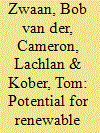| Srl | Item |
| 1 |
ID:
098702


|
|
|
|
|
| Publication |
2010.
|
| Summary/Abstract |
Stabilising the concentration of CO2 in the atmosphere at a level of 450 ppm in order to keep global temperature increase below 2 °C requires an ambitious climate policy. This study analyses the role of different technologies in the EU-27 with regard to efficiency improvements, fuel switching and energy saving measures under such a climate policy target. The analysis is carried out using the regionalised Pan-European TIMES energy system model, a technology oriented, linear optimisation model. Thereby limited resources and import potentials of various energy carriers, competition among different sectors and the country-specific differences in energy demand are taken into account. As a result, it turns out that the structure of energy use inside the EU-27 is much stronger, influenced by political targets and positions regarding climate protection, energy security and the use of nuclear energy than by available technologies. In the case of climate protection polices and limited use of nuclear energy, the most important measures for the reduction of greenhouse gases are an increased use of renewables, carbon capture and storage, fuel switching and the intensified application of electricity in the end use sectors. Efficiency improvements play an additional role when security of supply is taken into account.
|
|
|
|
|
|
|
|
|
|
|
|
|
|
|
|
| 2 |
ID:
124251


|
|
|
|
|
| Publication |
2013.
|
| Summary/Abstract |
Based on employment factors derived from a recent review of publications investigating opportunities for work associated with the diffusion of renewable energy technology, we here present an analysis of the potential for renewable energy jobs in the Middle East. We use energy system optimisation results from the regionally disaggregated TIAM-ECN model as input to our study. This integrated assessment model is utilised to inspect the energy technology requirements for meeting a stringent global climate policy that achieves a stabilisation of greenhouse gas concentrations in the atmosphere with a maximum additional radiative forcing of 2.9 W/m2. This climate control target implies a massive deployment of renewable energy in the Middle East, with wind and solar power accounting for approximately 60% of total electricity supply in 2050: 900 TWh of an overall level of 1525 TWh would be generated from 210 GW of installed renewable energy capacity by the middle of the century. For this pervasive renewables diffusion scenario for the Middle East we estimate a total required local work force of ultimately about 155,000 direct and 115,000 indirect jobs, based on assumptions regarding which components of the respective wind and solar energy technologies can be manufactured in the region itself. All jobs generated through installation and O&M activities are assumed to be domestic.
|
|
|
|
|
|
|
|
|
|
|
|
|
|
|
|